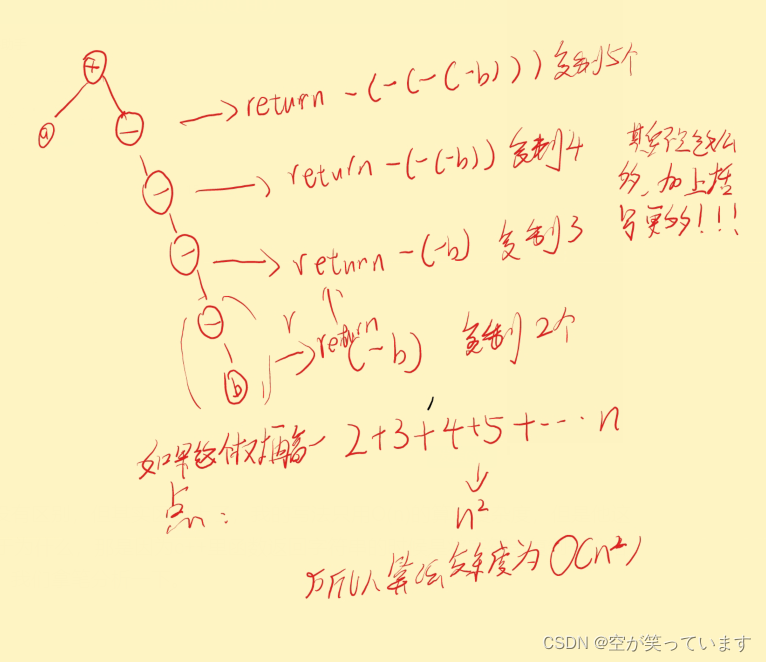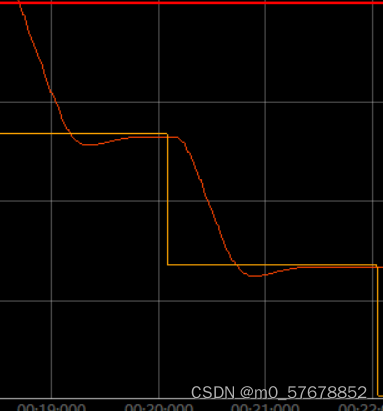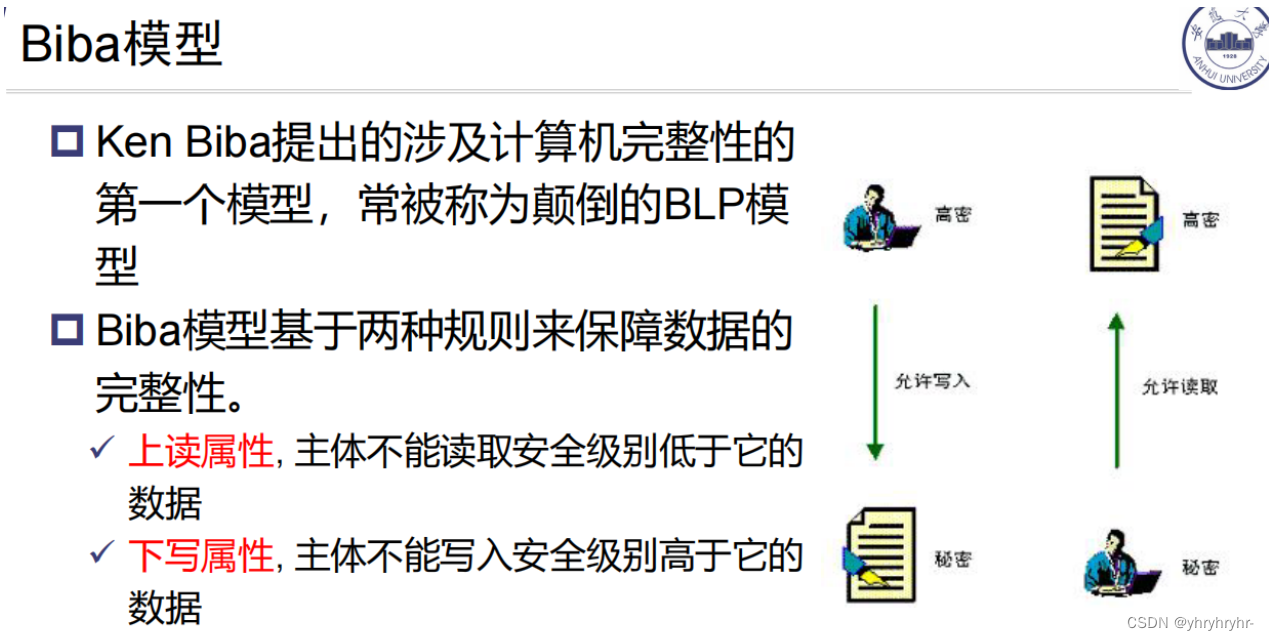一、前言
本文将介绍ChatGLM-6B的模型结构组件源码。
代练链接:https://huggingface.co/THUDM/chatglm-6b/blob/main/modeling_chatglm.py
二、激活函数
@torch.jit.script
def gelu_impl(x):
"""OpenAI's gelu implementation."""
return 0.5 * x * (1.0 + torch.tanh(0.7978845608028654 * x *
(1.0 + 0.044715 * x * x)))
def gelu(x):
return gelu_impl(x)
三、位置编码
3.1、RoPE原理简介
ChatGLM-6B的位置编码采用的旋转位置编码(详细推导过程见原文:ROPE),简单来说其目的就是构建一个包含相对位置信息的Attention矩阵,其公式如下:
(
R
m
q
)
⊤
(
R
n
k
)
=
q
⊤
R
m
⊤
R
n
k
=
q
⊤
R
n
−
m
k
\left(\boldsymbol{\mathcal { R }}_m \boldsymbol{q}\right)^{\top}\left(\boldsymbol{\mathcal { R }}_n \boldsymbol{k}\right)=\boldsymbol{q}^{\top} \boldsymbol{\mathcal { R }}_m^{\top} \boldsymbol{\mathcal { R }}_n \boldsymbol{k}=\boldsymbol{q}^{\top} \boldsymbol{\mathcal { R }}_{n-m} \boldsymbol{k}
(Rmq)⊤(Rnk)=q⊤Rm⊤Rnk=q⊤Rn−mk
式中,
q
q
q、
k
k
k分别表示注意力机制中的query和key,
m
m
m、
n
n
n分别表示两个位置,
R
i
R_i
Ri表示位置i处处理的矩阵,其中
R
R
R的形式为:
(
cos
m
θ
0
−
sin
m
θ
0
0
0
⋯
0
0
sin
m
θ
0
cos
m
θ
0
0
0
⋯
0
0
0
0
cos
m
θ
1
−
sin
m
θ
1
⋯
0
0
0
0
sin
m
θ
1
cos
m
θ
1
⋯
0
0
⋮
⋮
⋮
⋮
⋱
⋮
⋮
0
0
0
0
⋯
cos
m
θ
d
/
2
−
1
−
sin
m
θ
d
/
2
−
1
0
0
0
0
⋯
sin
m
θ
d
/
2
−
1
cos
m
θ
d
/
2
−
1
)
\left(\begin{array}{ccccccc} \cos m \theta_0 & -\sin m \theta_0 & 0 & 0 & \cdots & 0 & 0 \\ \sin m \theta_0 & \cos m \theta_0 & 0 & 0 & \cdots & 0 & 0 \\ 0 & 0 & \cos m \theta_1 & -\sin m \theta_1 & \cdots & 0 & 0 \\ 0 & 0 & \sin m \theta_1 & \cos m \theta_1 & \cdots & 0 & 0 \\ \vdots & \vdots & \vdots & \vdots & \ddots & \vdots & \vdots \\ 0 & 0 & 0 & 0 & \cdots & \cos m \theta_{d / 2-1} & -\sin m \theta_{d / 2-1} \\ 0 & 0 & 0 & 0 & \cdots & \sin m \theta_{d / 2-1} & \cos m \theta_{d / 2-1} \end{array}\right)
cosmθ0sinmθ000⋮00−sinmθ0cosmθ000⋮0000cosmθ1sinmθ1⋮0000−sinmθ1cosmθ1⋮00⋯⋯⋯⋯⋱⋯⋯0000⋮cosmθd/2−1sinmθd/2−10000⋮−sinmθd/2−1cosmθd/2−1
原作者提到,由于
R
R
R非常稀疏,直接用矩阵乘法来实现会很浪费算力,推荐通过下述方式来实现RoPE:
(
q
0
q
1
q
2
q
3
⋮
q
d
−
2
q
d
−
1
)
⊗
(
cos
m
θ
0
cos
m
θ
0
cos
m
θ
1
cos
m
θ
1
⋮
cos
m
θ
d
/
2
−
1
cos
m
θ
d
/
2
−
1
)
+
(
−
q
1
q
0
−
q
3
q
2
⋮
−
q
d
−
1
q
d
−
2
)
⊗
(
sin
m
θ
0
sin
m
θ
0
sin
m
θ
1
sin
m
θ
1
⋮
sin
m
θ
d
/
2
−
1
sin
m
θ
d
/
2
−
1
)
\left(\begin{array}{c} q_0 \\ q_1 \\ q_2 \\ q_3 \\ \vdots \\ q_{d-2} \\ q_{d-1} \end{array}\right) \otimes\left(\begin{array}{c} \cos m \theta_0 \\ \cos m \theta_0 \\ \cos m \theta_1 \\ \cos m \theta_1 \\ \vdots \\ \cos m \theta_{d / 2-1} \\ \cos m \theta_{d / 2-1} \end{array}\right)+\left(\begin{array}{c} -q_1 \\ q_0 \\ -q_3 \\ q_2 \\ \vdots \\ -q_{d-1} \\ q_{d-2} \end{array}\right) \otimes\left(\begin{array}{c} \sin m \theta_0 \\ \sin m \theta_0 \\ \sin m \theta_1 \\ \sin m \theta_1 \\ \vdots \\ \sin m \theta_{d / 2-1} \\ \sin m \theta_{d / 2-1} \end{array}\right)
q0q1q2q3⋮qd−2qd−1
⊗
cosmθ0cosmθ0cosmθ1cosmθ1⋮cosmθd/2−1cosmθd/2−1
+
−q1q0−q3q2⋮−qd−1qd−2
⊗
sinmθ0sinmθ0sinmθ1sinmθ1⋮sinmθd/2−1sinmθd/2−1
3.2、ChatGLM-6B中RoPE代码实现
这里直接上代码阅读
class RotaryEmbedding(torch.nn.Module):
def __init__(self, dim, base=10000, precision=torch.half, learnable=False):
super().__init__()
inv_freq = 1. / (base ** (torch.arange(0, dim, 2).float() / dim))
inv_freq = inv_freq.half()
self.learnable = learnable
if learnable:
self.inv_freq = torch.nn.Parameter(inv_freq)
self.max_seq_len_cached = None
else:
self.register_buffer('inv_freq', inv_freq)
self.max_seq_len_cached = None
self.cos_cached = None
self.sin_cached = None
self.precision = precision
def _load_from_state_dict(self, state_dict, prefix, local_metadata, strict, missing_keys, unexpected_keys,
error_msgs):
pass
def forward(self, x, seq_dim=1, seq_len=None):
if seq_len is None:
seq_len = x.shape[seq_dim]
if self.max_seq_len_cached is None or (seq_len > self.max_seq_len_cached):
self.max_seq_len_cached = None if self.learnable else seq_len
# 在计算旋转嵌入之前,根据当前的嵌入维度和基数计算频率因子 inv_freq。将其转换为半精度数据类型(如果指定的 precision 为 bfloat16,则转换为单精度)。
t = torch.arange(seq_len, device=x.device, dtype=self.inv_freq.dtype)
# 使用 爱因斯坦求和函数 einsum 将 t 和 inv_freq 相乘,得到频率矩阵 freqs。
freqs = torch.einsum('i,j->ij', t, self.inv_freq)
# 通过在频率矩阵 freqs 中进行重复和拼接操作,生成旋转嵌入矩阵 emb,其维度为 [seq_len, 2 * dim]。
emb = torch.cat((freqs, freqs), dim=-1).to(x.device)
if self.precision == torch.bfloat16:
emb = emb.float()
# 将旋转嵌入矩阵 emb 分别进行余弦和正弦运算。
cos_cached = emb.cos()[:, None, :]
sin_cached = emb.sin()[:, None, :]
if self.precision == torch.bfloat16:
cos_cached = cos_cached.bfloat16()
sin_cached = sin_cached.bfloat16()
if self.learnable:
return cos_cached, sin_cached
self.cos_cached, self.sin_cached = cos_cached, sin_cached
# 按照序列长度截取
return self.cos_cached[:seq_len, ...], self.sin_cached[:seq_len, ...]
四、注意力层
4.1、2D位置编码
ChatGLM-6B代码中这一层采用的位置编码是GLM的中提出的2D位置编码,详细原理见原文:GLM: General Language Model Pretraining with Autoregressive Blank Infilling,其原理图如下图:
![[外链图片转存失败,源站可能有防盗链机制,建议将图片保存下来直接上传(img-IxelDRzx-1684310348631)(F:\weixin\imgs\image-20230517141516431.png)]](https://img-blog.csdnimg.cn/fa21b7effc0e41efa43096f72d02cb05.png)
输入的序列是 x 1 , x 2 , x 3 , x 4 , x 5 , x 6 x_1,x_2,x_3,x_4,x_5,x_6 x1,x2,x3,x4,x5,x6,片段 x 3 x_3 x3和片段 x 5 、 x 6 x_5、x_6 x5、x6被随机MASK,原始的输入序列则变为 x 1 , x 2 , [ M ] , x 4 , [ M ] x_1,x_2,[M], x_4,[M] x1,x2,[M],x4,[M],如上图(a)和(b)所示。将三个片段拼接得到模型的输入 x 1 , x 2 , [ M ] , x 4 , [ M ] , [ S ] , x 5 , x 6 , [ S ] , x 3 x_1,x_2,[M], x_4,[M],[S],x_5,x_6,[S],x_3 x1,x2,[M],x4,[M],[S],x5,x6,[S],x3,模型的输出则是被遮蔽掉的片段,如上图©所示。这里使用了2种位置编码:第一种编码为整个输入嵌入位置信息,能够表示MASK片段在原始输入中的位置;第二种位置编码则是为MASK片段内的tokens输入位置信息。
4.2、注意力机制
ChatGLM-6B相比标准的自注意力机制在Q和K中注入了RoPE位置信息。
- 标准自注意力机制attention_fn:
def attention_fn(
self,
query_layer,
key_layer,
value_layer,
attention_mask,
hidden_size_per_partition,
layer_id,
layer_past=None,
scaling_attention_score=True,
use_cache=False,
):
# 考虑过去的信息
if layer_past is not None:
past_key, past_value = layer_past
key_layer = torch.cat((past_key, key_layer), dim=0)
value_layer = torch.cat((past_value, value_layer), dim=0)
# seqlen, batch, num_attention_heads, hidden_size_per_attention_head
seq_len, b, nh, hidden_size = key_layer.shape
if use_cache:
present = (key_layer, value_layer)
else:
present = None
# 对查询层进行缩放操作,即将其除以(隐藏层大小的平方根乘以查询层的缩放系数)。这是为了控制注意力得分的尺度。
query_key_layer_scaling_coeff = float(layer_id + 1)
if scaling_attention_score:
query_layer = query_layer / (math.sqrt(hidden_size) * query_key_layer_scaling_coeff)
# ===================================
# Raw attention scores. [b, np, s, s]
# ===================================
# # 注意力分数的输出形状: [batch_size, num_heads, seq_length, seq_length]
output_size = (query_layer.size(1), query_layer.size(2), query_layer.size(0), key_layer.size(0))
# 形状重塑:[seq_length, batch_size, num_heads, head_dim] -> [seq_length, batch_size*num_heads, head_dim]
# [sq, b, np, hn] -> [sq, b * np, hn]
query_layer = query_layer.view(output_size[2], output_size[0] * output_size[1], -1)
# [sk, b, np, hn] -> [sk, b * np, hn]
key_layer = key_layer.view(output_size[3], output_size[0] * output_size[1], -1)
matmul_result = torch.empty(
output_size[0] * output_size[1],
output_size[2],
output_size[3],
dtype=query_layer.dtype,
device=query_layer.device,
)
# 计算原始的注意力得分,通过转置和重塑操作,将查询、键和值的张量形状调整为合适的形状。
matmul_result = torch.baddbmm(
matmul_result,
query_layer.transpose(0, 1), # [b * np, sq, hn]
key_layer.transpose(0, 1).transpose(1, 2), # [b * np, hn, sk]
beta=0.0,
alpha=1.0,
)
# 重塑形状为:[batch_size,num_head,seq_length,seq_length]
attention_scores = matmul_result.view(*output_size)
# 如果指定了缩放的掩码 softmax(scale_mask_softmax),则将注意力得分传递给缩放的掩码 softmax 函数进行处理,以获得归一化的注意力概率。
# 否则,将应用 softmax 操作,并根据需要填充一个较大的负数值(-10000.0)来屏蔽无效位置。
if self.scale_mask_softmax:
self.scale_mask_softmax.scale = query_key_layer_scaling_coeff
attention_probs = self.scale_mask_softmax(attention_scores, attention_mask.contiguous())
else:
# 对注意力分数进行mask
if not (attention_mask == 0).all():
# if auto-regressive, skip
attention_scores.masked_fill_(attention_mask, -10000.0)
dtype = attention_scores.type()
attention_scores = attention_scores.float()
attention_scores = attention_scores * query_key_layer_scaling_coeff
attention_probs = F.softmax(attention_scores, dim=-1)
attention_probs = attention_probs.type(dtype)
# =========================
# Context layer. [sq, b, hp]
# =========================
# value_layer -> context layer.
# [sk, b, np, hn] --> [b, np, sq, hn]
# context layer shape: [b, np, sq, hn]
output_size = (value_layer.size(1), value_layer.size(2), query_layer.size(0), value_layer.size(3))
# change view [sk, b * np, hn]
value_layer = value_layer.view(value_layer.size(0), output_size[0] * output_size[1], -1)
# 对注意力分数进行mask
# change view [b * np, sq, sk]
attention_probs = attention_probs.view(output_size[0] * output_size[1], output_size[2], -1)
# matmul: [b * np, sq, hn]
context_layer = torch.bmm(attention_probs, value_layer.transpose(0, 1))
# change view [b, np, sq, hn]
context_layer = context_layer.view(*output_size)
# [b, np, sq, hn] --> [sq, b, np, hn]
context_layer = context_layer.permute(2, 0, 1, 3).contiguous()
# [sq, b, np, hn] --> [sq, b, hp]
new_context_layer_shape = context_layer.size()[:-2] + (hidden_size_per_partition,)
# 重塑上下文层
context_layer = context_layer.view(*new_context_layer_shape)
outputs = (context_layer, present, attention_probs)
return outputs
-
SelfAttention的目的是为了捕捉序列中的位置信息,应用RoPE将位置信息注入Q和K。
class SelfAttention(torch.nn.Module): def __init__(self, hidden_size, num_attention_heads, layer_id, hidden_size_per_attention_head=None, bias=True, params_dtype=torch.float, position_encoding_2d=True): super(SelfAttention, self).__init__() self.layer_id = layer_id self.hidden_size = hidden_size self.hidden_size_per_partition = hidden_size self.num_attention_heads = num_attention_heads self.num_attention_heads_per_partition = num_attention_heads self.position_encoding_2d = position_encoding_2d self.rotary_emb = RotaryEmbedding( self.hidden_size // (self.num_attention_heads * 2) if position_encoding_2d else self.hidden_size // self.num_attention_heads, base=10000, precision=torch.half, learnable=False, ) self.scale_mask_softmax = None if hidden_size_per_attention_head is None: self.hidden_size_per_attention_head = hidden_size // num_attention_heads else: self.hidden_size_per_attention_head = hidden_size_per_attention_head self.inner_hidden_size = num_attention_heads * self.hidden_size_per_attention_head # Strided linear layer. self.query_key_value = skip_init( torch.nn.Linear, hidden_size, 3 * self.inner_hidden_size, bias=bias, dtype=params_dtype, ) self.dense = skip_init( torch.nn.Linear, self.inner_hidden_size, hidden_size, bias=bias, dtype=params_dtype, ) @staticmethod def attention_mask_func(attention_scores, attention_mask): attention_scores.masked_fill_(attention_mask, -10000.0) return attention_scores def split_tensor_along_last_dim(self, tensor, num_partitions, contiguous_split_chunks=False): """Split a tensor along its last dimension. Arguments: tensor: input tensor. num_partitions: number of partitions to split the tensor contiguous_split_chunks: If True, make each chunk contiguous in memory. """ # Get the size and dimension. last_dim = tensor.dim() - 1 last_dim_size = tensor.size()[last_dim] // num_partitions # Split. tensor_list = torch.split(tensor, last_dim_size, dim=last_dim) # Note: torch.split does not create contiguous tensors by default. if contiguous_split_chunks: return tuple(chunk.contiguous() for chunk in tensor_list) return tensor_list def forward( self, hidden_states: torch.Tensor, position_ids, attention_mask: torch.Tensor, layer_id, layer_past: Optional[Tuple[torch.Tensor, torch.Tensor]] = None, use_cache: bool = False, output_attentions: bool = False, ): """ hidden_states: [seq_len, batch, hidden_size] attention_mask: [(1, 1), seq_len, seq_len] """ # [seq_len, batch, 3 * hidden_size] mixed_raw_layer = self.query_key_value(hidden_states) # [seq_len, batch, 3 * hidden_size] --> [seq_len, batch, num_attention_heads, 3 * hidden_size_per_attention_head] new_tensor_shape = mixed_raw_layer.size()[:-1] + ( self.num_attention_heads_per_partition, 3 * self.hidden_size_per_attention_head, ) mixed_raw_layer = mixed_raw_layer.view(*new_tensor_shape) # [seq_len, batch, num_attention_heads, hidden_size_per_attention_head] (query_layer, key_layer, value_layer) = self.split_tensor_along_last_dim(mixed_raw_layer, 3) # 根据是否使用二维位置编码,对查询和键应用旋转嵌入,并根据位置信息进行索引操作。 if self.position_encoding_2d: q1, q2 = query_layer.chunk(2, dim=(query_layer.ndim - 1)) k1, k2 = key_layer.chunk(2, dim=(key_layer.ndim - 1)) cos, sin = self.rotary_emb(q1, seq_len=position_ids.max() + 1) position_ids, block_position_ids = position_ids[:, 0, :].transpose(0, 1).contiguous(), \ position_ids[:, 1, :].transpose(0, 1).contiguous() q1, k1 = apply_rotary_pos_emb_index(q1, k1, cos, sin, position_ids) q2, k2 = apply_rotary_pos_emb_index(q2, k2, cos, sin, block_position_ids) # 拼接嵌入不同位置信息的query和key,这样query和key中包含了两种位置信息 query_layer = torch.concat([q1, q2], dim=(q1.ndim - 1)) key_layer = torch.concat([k1, k2], dim=(k1.ndim - 1)) else: # RoPE position_ids = position_ids.transpose(0, 1) cos, sin = self.rotary_emb(value_layer, seq_len=position_ids.max() + 1) # [seq_len, batch, num_attention_heads, hidden_size_per_attention_head] query_layer, key_layer = apply_rotary_pos_emb_index(query_layer, key_layer, cos, sin, position_ids) # 调用 attention_fn 方法计算注意力得分和上下文层,其中使用了注意力函数的代码块 # [seq_len, batch, hidden_size] context_layer, present, attention_probs = attention_fn( self=self, query_layer=query_layer, key_layer=key_layer, value_layer=value_layer, attention_mask=attention_mask, hidden_size_per_partition=self.hidden_size_per_partition, layer_id=layer_id, layer_past=layer_past, use_cache=use_cache ) output = self.dense(context_layer) outputs = (output, present) if output_attentions: outputs += (attention_probs,) return outputs # output, present, attention_probs五、GLU层
根据代码,GLU形式化表示为:
G L U ( X ) = G E L U ( X W 1 ) W 2 GLU(X)=GELU(XW_1)W_2 GLU(X)=GELU(XW1)W2class GEGLU(torch.nn.Module): def __init__(self): super().__init__() self.activation_fn = F.gelu def forward(self, x): # dim=-1 breaks in jit for pt<1.10 x1, x2 = x.chunk(2, dim=(x.ndim - 1)) return x1 * self.activation_fn(x2) class GLU(torch.nn.Module): def __init__(self, hidden_size, inner_hidden_size=None, layer_id=None, bias=True, activation_func=gelu, params_dtype=torch.float): super(GLU, self).__init__() self.layer_id = layer_id self.activation_func = activation_func # Project to 4h. self.hidden_size = hidden_size if inner_hidden_size is None: inner_hidden_size = 4 * hidden_size self.inner_hidden_size = inner_hidden_size self.dense_h_to_4h = skip_init( torch.nn.Linear, self.hidden_size, self.inner_hidden_size, bias=bias, dtype=params_dtype, ) # Project back to h. self.dense_4h_to_h = skip_init( torch.nn.Linear, self.inner_hidden_size, self.hidden_size, bias=bias, dtype=params_dtype, ) def forward(self, hidden_states): """ hidden_states: [seq_len, batch, hidden_size] """ # [seq_len, batch, inner_hidden_size] intermediate_parallel = self.dense_h_to_4h(hidden_states) intermediate_parallel = self.activation_func(intermediate_parallel) output = self.dense_4h_to_h(intermediate_parallel) return output六、GLMBlock
根据代码,GLMBlock由Layer Norm、Self Attention、Layer Norm和GLU模块构成。
![[外链图片转存失败,源站可能有防盗链机制,建议将图片保存下来直接上传(img-ntIs2FQK-1684310348633)(F:\weixin\imgs\image-20230517152442140.png)]](https://img-blog.csdnimg.cn/d0f1a45d7e844bf1a0a2c23087c978fc.png)
class GLMBlock(torch.nn.Module):
def __init__(
self,
hidden_size,
num_attention_heads,
layernorm_epsilon,
layer_id,
inner_hidden_size=None,
hidden_size_per_attention_head=None,
layernorm=LayerNorm,
use_bias=True,
params_dtype=torch.float,
num_layers=28,
position_encoding_2d=True
):
super(GLMBlock, self).__init__()
# Set output layer initialization if not provided.
self.layer_id = layer_id
# LayerNorm层
self.input_layernorm = layernorm(hidden_size, eps=layernorm_epsilon)
# 是否使用2维位置编码
self.position_encoding_2d = position_encoding_2d
# 自注意力层
self.attention = SelfAttention(
hidden_size,
num_attention_heads,
layer_id,
hidden_size_per_attention_head=hidden_size_per_attention_head,
bias=use_bias,
params_dtype=params_dtype,
position_encoding_2d=self.position_encoding_2d
)
# LayerNorm层
self.post_attention_layernorm = layernorm(hidden_size, eps=layernorm_epsilon)
self.num_layers = num_layers
# GLU层
self.mlp = GLU(
hidden_size,
inner_hidden_size=inner_hidden_size,
bias=use_bias,
layer_id=layer_id,
params_dtype=params_dtype,
)
def forward(
self,
hidden_states: torch.Tensor,
position_ids,
attention_mask: torch.Tensor,
layer_id,
layer_past: Optional[Tuple[torch.Tensor, torch.Tensor]] = None,
use_cache: bool = False,
output_attentions: bool = False,
):
"""
hidden_states: [seq_len, batch, hidden_size]
attention_mask: [(1, 1), seq_len, seq_len]
"""
# 输入进行Layer Norm
# [seq_len, batch, hidden_size]
attention_input = self.input_layernorm(hidden_states)
# 自注意力
attention_outputs = self.attention(
attention_input,
position_ids,
attention_mask=attention_mask,
layer_id=layer_id,
layer_past=layer_past,
use_cache=use_cache,
output_attentions=output_attentions
)
attention_output = attention_outputs[0]
outputs = attention_outputs[1:]
# Residual connection.
alpha = (2 * self.num_layers) ** 0.5
# 执行注意力残差连接
hidden_states = attention_input * alpha + attention_output
# 对注意力残差连接后的输出进行层归一化
mlp_input = self.post_attention_layernorm(hidden_states)
# 使用GLU层对归一化后的输出进行非线性变换
mlp_output = self.mlp(mlp_input)
# 执行GLU残差连接
output = mlp_input * alpha + mlp_output
if use_cache:
outputs = (output,) + outputs
else:
outputs = (output,) + outputs[1:]
return outputs # hidden_states, present, attentions
七、ChatGLMPreTrainedModel
这一块主要看看其中的MASK和Position_ids
7.1、ChatGLM-6B的Mask
ChatGLM-6B采用prefix-LM的Mask,其对于输入的前缀使用双向注意力,对于后续的生成部分则是Causal Mask。
![[外链图片转存失败,源站可能有防盗链机制,建议将图片保存下来直接上传(img-zNYjuXzC-1684310348633)(F:\weixin\imgs\image-20230517150353969.png)]](https://img-blog.csdnimg.cn/0fad0497304d413eb8a42db7da396889.png)
def get_masks(self, input_ids, device):
batch_size, seq_length = input_ids.shape
# context_lengths记录了batch中每个样本的真实长度
context_lengths = [seq.tolist().index(self.config.bos_token_id) for seq in input_ids]
# 生成causal mask,即下三角以及对角线为1,上三角为0
attention_mask = torch.ones((batch_size, seq_length, seq_length), device=device)
attention_mask.tril_()
# 将前缀部分的注意力改为双向注意力
for i, context_length in enumerate(context_lengths):
attention_mask[i, :, :context_length] = 1
attention_mask.unsqueeze_(1)
attention_mask = (attention_mask < 0.5).bool()
return attention_mask
7.2、ChatGLM-6B的Position_ids
def get_position_ids(self, input_ids, mask_positions, device, use_gmasks=None):
"""
input_ids: [batch_size, seq_length]
mask_positions: [batch_size],由于GLM系列中会使用[Mask]或[gMask]标志,mask_positions就是指这些标注的具体位置
"""
batch_size, seq_length = input_ids.shape
if use_gmasks is None:
use_gmasks = [False] * batch_size
# context_lengths:未被padding前,batch中各个样本的长度
context_lengths = [seq.tolist().index(self.config.bos_token_id) for seq in input_ids]
# 2维位置编码
if self.position_encoding_2d:
# [0,1,2,...,seq_length-1]
position_ids = torch.arange(seq_length, dtype=torch.long, device=device).unsqueeze(0).repeat(batch_size, 1)
# 将原始输入后所有位置的postion id都设置为[Mask]或者[gMask]的位置id
for i, context_length in enumerate(context_lengths):
position_ids[i, context_length:] = mask_positions[i]
# 原始输入的位置编码全部设置为0,待生成的位置添加顺序的位置id
# 例如:[0,0,0,0,1,2,3,4,5]
block_position_ids = [torch.cat((
torch.zeros(context_length, dtype=torch.long, device=device),
torch.arange(seq_length - context_length, dtype=torch.long, device=device) + 1
)) for context_length in context_lengths]
block_position_ids = torch.stack(block_position_ids, dim=0)
# 将postion_ids和block_position_ids堆叠在一起,用于后续的参数传入;
# 在注意力层中,还有将这个position_ids拆分为两部分
position_ids = torch.stack((position_ids, block_position_ids), dim=1)
else:
position_ids = torch.arange(seq_length, dtype=torch.long, device=device).unsqueeze(0).repeat(batch_size, 1)
for i, context_length in enumerate(context_lengths):
if not use_gmasks[i]:
position_ids[i, context_length:] = mask_positions[i]
return position_ids
八、ChatGLMModel
这一块主要是模型的各部件的组合结构,直接看源码:
class ChatGLMModel(ChatGLMPreTrainedModel):
def __init__(self, config: ChatGLMConfig, empty_init=True):
super().__init__(config)
if empty_init:
init_method = skip_init
else:
init_method = default_init
# recording parameters
self.max_sequence_length = config.max_sequence_length
self.hidden_size = config.hidden_size
self.params_dtype = torch.half
self.num_attention_heads = config.num_attention_heads
self.vocab_size = config.vocab_size
self.num_layers = config.num_layers
self.layernorm_epsilon = config.layernorm_epsilon
self.inner_hidden_size = config.inner_hidden_size
self.hidden_size_per_attention_head = self.hidden_size // self.num_attention_heads
self.position_encoding_2d = config.position_encoding_2d
self.pre_seq_len = config.pre_seq_len
self.prefix_projection = config.prefix_projection
self.word_embeddings = init_method(
torch.nn.Embedding,
num_embeddings=self.vocab_size, embedding_dim=self.hidden_size,
dtype=self.params_dtype
)
self.gradient_checkpointing = False
def get_layer(layer_id):
return GLMBlock(
self.hidden_size,
self.num_attention_heads,
self.layernorm_epsilon,
layer_id,
inner_hidden_size=self.inner_hidden_size,
hidden_size_per_attention_head=self.hidden_size_per_attention_head,
layernorm=LayerNorm,
use_bias=True,
params_dtype=self.params_dtype,
position_encoding_2d=self.position_encoding_2d,
empty_init=empty_init
)
self.layers = torch.nn.ModuleList(
[get_layer(layer_id) for layer_id in range(self.num_layers)]
)
# Final layer norm before output.
self.final_layernorm = LayerNorm(self.hidden_size, eps=self.layernorm_epsilon)
"""
pre_seq_len 为prompt部分长度,这部分仅编码,无反向传播
"""
if self.pre_seq_len is not None:
for param in self.parameters():
param.requires_grad = False
self.prefix_tokens = torch.arange(self.pre_seq_len).long()
self.prefix_encoder = PrefixEncoder(config)
self.dropout = torch.nn.Dropout(0.1)
def get_prompt(self, batch_size, device, dtype=torch.half):
"""
prompt 编码
"""
prefix_tokens = self.prefix_tokens.unsqueeze(0).expand(batch_size, -1).to(device)
past_key_values = self.prefix_encoder(prefix_tokens).type(dtype)
past_key_values = past_key_values.view(
batch_size,
self.pre_seq_len,
self.num_layers * 2,
self.num_attention_heads,
self.hidden_size // self.num_attention_heads
)
# seq_len, b, nh, hidden_size
past_key_values = self.dropout(past_key_values)
past_key_values = past_key_values.permute([2, 1, 0, 3, 4]).split(2)
# past_key_values = [(v[0], v[1]) for v in past_key_values]
return past_key_values
def forward(
self,
input_ids: Optional[torch.LongTensor] = None,
position_ids: Optional[torch.LongTensor] = None,
attention_mask: Optional[torch.Tensor] = None,
past_key_values: Optional[Tuple[Tuple[torch.Tensor, torch.Tensor], ...]] = None,
inputs_embeds: Optional[torch.LongTensor] = None,
use_cache: Optional[bool] = None,
output_attentions: Optional[bool] = None,
output_hidden_states: Optional[bool] = None,
return_dict: Optional[bool] = None,
) -> Union[Tuple[torch.Tensor, ...], BaseModelOutputWithPast]:
.....
"""
past_key_values机制是重要的机制,其可以防止模型在文本生成任务中重新计算上一次迭代
中已经计算好的上下文的值,大大提高了模型在文本生成任务中的计算效率。但要特别注意的是,
在第一次迭代时由于不存在上一次迭代返回的past_key_values值,因此第一次迭代时
past_key_values值为None。
past_key_values 中每个元素的dim :
num_layers * seq_len * batch_size * nh * hidden_size_per_head
"""
if past_key_values is None:
if self.pre_seq_len is not None:
past_key_values = self.get_prompt(batch_size=input_ids.shape[0], device=input_ids.device,
dtype=inputs_embeds.dtype)
else:
past_key_values = tuple([None] * len(self.layers))
if attention_mask is None:
attention_mask = self.get_masks(
input_ids,
device=input_ids.device
)
if position_ids is None:
"""
如果只有MASK无gMASK,则mask_positions 为第一个MASK的起始位置,
如果有gMASK, 则mask_positions 为第一个gMASK的起始位置
e.g.
gMASK = 130001
MASK = 130000
seqs = [[11,22,MASK,33,MASK]]
--> mask_positions:[2] use_gmask = [False]
gMASK = 130001
MASK = 130000
seqs = seqs = [[11,22,MASK,33,MASK, gMASK, 55, 66, gMASK, 77]]
--> mask_positions:[5] use_gmask = [True]
把位置id结合mask位置信息由get_position_ids计算(为父类ChatGLMPreTrainedModel的方法)
在使用2d position coding 时,position_ids dim = batch_size * 2 * seq_length
第二维包含 position_id 和 block_position_id
"""
MASK, gMASK = self.config.mask_token_id, self.config.gmask_token_id
seqs = input_ids.tolist()
mask_positions, use_gmasks = [], []
for seq in seqs:
mask_token = gMASK if gMASK in seq else MASK
use_gmask = mask_token == gMASK
mask_positions.append(seq.index(mask_token))
use_gmasks.append(use_gmask)
position_ids = self.get_position_ids(
input_ids,
mask_positions=mask_positions,
device=input_ids.device,
use_gmasks=use_gmasks
)
if self.pre_seq_len is not None and attention_mask is not None:
prefix_attention_mask = torch.ones(batch_size, 1, input_ids.size(-1), self.pre_seq_len).to(
attention_mask.device)
prefix_attention_mask = (prefix_attention_mask < 0.5).bool()
attention_mask = torch.cat((prefix_attention_mask, attention_mask), dim=3)
"""
输入的embedding在这里进行了转置
batch_size * seq_len * hidden_size -> seq_len * batch_size * hidden_size
"""
# [seq_len, batch, hidden_size]
hidden_states = inputs_embeds.transpose(0, 1)
presents = () if use_cache else None
all_self_attentions = () if output_attentions else None
all_hidden_states = () if output_hidden_states else None
if attention_mask is None:
attention_mask = torch.zeros(1, 1, device=input_ids.device).bool()
else:
attention_mask = attention_mask.to(hidden_states.device)
for i, layer in enumerate(self.layers):
if output_hidden_states:
all_hidden_states = all_hidden_states + (hidden_states,)
layer_past = past_key_values[i]
if self.gradient_checkpointing and self.training:
layer_ret = torch.utils.checkpoint.checkpoint(
layer,
hidden_states,
position_ids,
attention_mask,
torch.tensor(i),
layer_past,
use_cache,
output_attentions
)
else:
layer_ret = layer(
hidden_states,
position_ids=position_ids,
attention_mask=attention_mask,
layer_id=torch.tensor(i),
layer_past=layer_past,
use_cache=use_cache,
output_attentions=output_attentions
)
hidden_states = layer_ret[0]
if use_cache:
presents = presents + (layer_ret[1],)
if output_attentions:
all_self_attentions = all_self_attentions + (layer_ret[2 if use_cache else 1],)
# Final layer norm.
hidden_states = self.final_layernorm(hidden_states)
if output_hidden_states:
all_hidden_states = all_hidden_states + (hidden_states,)
if not return_dict:
return tuple(v for v in [hidden_states, presents, all_hidden_states, all_self_attentions] if v is not None)
"""
经过多个glm block堆叠,最后通过一个layernorm
"""
return BaseModelOutputWithPast(
last_hidden_state=hidden_states,
past_key_values=presents,
hidden_states=all_hidden_states,
attentions=all_self_attentions,
)
如又不详细之处,还望一起交流学习。
参考文献
- GLM: General Language Model Pretraining with Autoregressive Blank Infilling)
- modeling_chatglm.py · THUDM/chatglm-6b at main (huggingface.co)
- Transformer升级之路:2、博采众长的旋转式位置编码 - 科学空间|Scientific Spaces (kexue.fm)





![[RapidOCRWeb] 桌面版使用教程](https://img-blog.csdnimg.cn/img_convert/458a1e5c99d7bf05fc4252fba84a069d.png)
